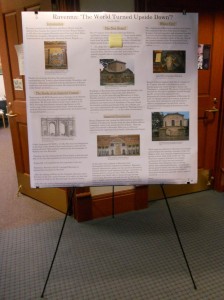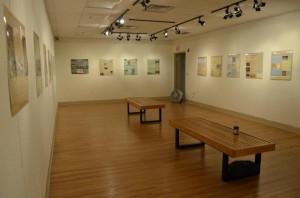Making a pop-up museum: Dusting off the Dark Ages
11 March 2015 – Ellen Arnold
At Ohio Wesleyan University, I teach an upper-level medieval history course, “Constantine to Charlemagne.” This is an undergraduate class, with 18 students of varying backgrounds. The course addresses a time period (ca. 300-850) often slandered as barbaric and backwards, so my goal is for students to see the richness, texture, and vibrancy of the period along with the political and economic troubles that befell certain areas. Over the course of the semester, as we work to understand a period famous for both its lack of historical sources and its network of diverging and converging cultures, we work together on how to explain and re-frame this period for a public audience.
A public history project like the one my students are embarking on this semester is unusual for medieval history courses. Though some medieval history professors and graduate students do discuss and practice public engagement through K-12 classroom visits, and libraries with important medieval manuscript collections are also reaching out to schools, the relative dearth of medieval history in American public history programs does not encourage many of us to think about the practice. Also, at many small schools like Ohio Wesleyan, there are no separate courses in public history. Yet more and more of my students are interested in public history, museum studies, and archival work. This project developed as a way to introduce students to the basic issues of museum design and audience engagement and to help them imagine a space for history that extends beyond the classroom. In our case, we are dusting off the ages and making a pop-up museum.
In many cases, content for pop-up museums has been audience-generated or has aimed to reinterpret extant objects and even to redefine what we think of as “museums” (see Michelle DelCarlo’s blog on the concept). Within the world of museums, my class project more closely resembles small-scale traveling exhibits, like this one on medieval armor or this one on Nazi propaganda, but I still choose to frame this project as a kind of “pop-up museum.” Why? In part because the student exhibits will be set up quickly and exist for a limited time and in part because the concept of the “pop up museum” helps students imagine a pared-down, handmade style and space. I also like the term because of the emphasis in some pop-up stores and restaurants on giving space to new ideas and relatively new practitioners.
Each student prepares her own exhibit panels to represent her own research and work. These panels are designed to be complete, stand-alone exhibits on the student’s chosen topic, and each student is evaluated individually. That said, each student is also assigned to be part of a group (five total), and each group is responsible for planning its portion of the exhibit, to find ways to link the individual student projects, and to explain the broader patterns of the pre-modern societies they are interpreting.
In expanding on our chosen theme of “People and Places,” our class has several challenges. First, we have no physical objects on hand. We are a small liberal arts school in the middle of Ohio. We have no artifacts from the many excavations of early medieval settlements. We have no original manuscripts from the period. We have no sculptures, coins, or tools. Second, I have some students who have taken four or five pre-modern courses and some who haven’t even had a history class since high school–and so navigating varying levels of student expertise is a real concern. The same could be said of our potential audience. Finally, as a “pop-up museum,” we don’t have a designated museum space.
I have addressed this third challenge in several ways over the years (I have taught this class both at OWU and at Macalester College in St. Paul, MN). Each approach offers limits and opportunities. The first time I taught the course, we transformed a large assembly space on campus using curtains to create a smaller and more structured space for our “pop-up.” The last time I taught the class, we used the student art gallery space and worked with the students in charge of lighting and hanging to get the exhibit mounted. Though this looked very polished, this time I am returning to a more “handmade” approach to give the class more agency in design and layout. We are using a large space in our library that will be a bit of a blank slate. With 22 posters anticipated, I am currently trying to track down every display easel on campus.
Throughout the semester, students consider issues of memory, history, public engagement, and audience. We talk about how history is a constructed narrative and how they as the designers of this exhibit will now be participating in that process. They will also, towards the end of the semester, take on additional “real life” museum roles. Some students will be the publicity committee. Some will plan and execute the installation. Others will plan and recruit participants for staffing on the days of the exhibit (it will take place over two school days) and run “gallery talks” and other informative sessions.
Ultimately, this is the students’ project to shape and to create. I help ensure historical accuracy, advise students, and manage the budget (I added a $25-student fee this year for supplies). But the students are the curators. They choose what stories to tell, how to tell them, and how to work with each other to accomplish something collectively that they could not do alone. Our bare-bones pop-up museum lets these medieval history students experience a taste of what it’s like to be a public historian. It also allows their work to be showcased on campus and lets the campus community appreciate the range of questions that medieval history can pose.
Ellen Arnold is an assistant professor of history at Ohio Wesleyan University.







Update: Today was the first day of the exhibit–students got it all set up, did some trouble-shooting and adjustment on the way, and have in general done a really great job of turning the space into a museum! I was hoping to post some photos, but it doesn’t look like I can–they used temporary walls and large display cases, and chose to include both a running slide show of maps and also ambient music. We were only open for a half-day, but tomorrow will be 9-5!